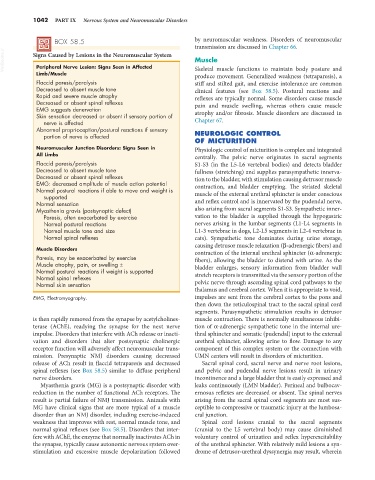Page 1070 - Small Animal Internal Medicine, 6th Edition
P. 1070
1042 PART IX Nervous System and Neuromuscular Disorders
BOX 58.5 by neuromuscular weakness. Disorders of neuromuscular
transmission are discussed in Chapter 66.
VetBooks.ir Signs Caused by Lesions in the Neuromuscular System Muscle
Peripheral Nerve Lesion: Signs Seen in Affected
Limb/Muscle Skeletal muscle functions to maintain body posture and
produce movement. Generalized weakness (tetraparesis), a
Flaccid paresis/paralysis stiff and stilted gait, and exercise intolerance are common
Decreased to absent muscle tone clinical features (see Box 58.5). Postural reactions and
Rapid and severe muscle atrophy reflexes are typically normal. Some disorders cause muscle
Decreased or absent spinal reflexes pain and muscle swelling, whereas others cause muscle
EMG suggests denervation
Skin sensation decreased or absent if sensory portion of atrophy and/or fibrosis. Muscle disorders are discussed in
nerve is affected Chapter 67.
Abnormal proprioception/postural reactions if sensory
portion of nerve is affected NEUROLOGIC CONTROL
OF MICTURITION
Neuromuscular Junction Disorders: Signs Seen in Physiologic control of micturition is complex and integrated
All Limbs centrally. The pelvic nerve originates in sacral segments
Flaccid paresis/paralysis S1-S3 (in the L5-L6 vertebral bodies) and detects bladder
Decreased to absent muscle tone fullness (stretching) and supplies parasympathetic innerva-
Decreased or absent spinal reflexes tion to the bladder, with stimulation causing detrusor muscle
EMG: decreased amplitude of muscle action potential contraction, and bladder emptying. The striated skeletal
Normal postural reactions if able to move and weight is
supported muscle of the external urethral sphincter is under conscious
Normal sensation and reflex control and is innervated by the pudendal nerve,
Myasthenia gravis (postsynaptic defect) also arising from sacral segments S1-S3. Sympathetic inner-
Paresis, often exacerbated by exercise vation to the bladder is supplied through the hypogastric
Normal postural reactions nerves arising in the lumbar segments (L1-L4 segments in
Normal muscle tone and size L1-3 vertebrae in dogs, L2-L5 segments in L2-4 vertebrae in
Normal spinal reflexes cats). Sympathetic tone dominates during urine storage,
causing detrusor muscle relaxation (β-adrenergic fibers) and
Muscle Disorders contraction of the internal urethral sphincter (α-adrenergic
Paresis, may be exacerbated by exercise fibers), allowing the bladder to distend with urine. As the
Muscle atrophy, pain, or swelling ± bladder enlarges, sensory information from bladder wall
Normal postural reactions if weight is supported
Normal spinal reflexes stretch receptors is transmitted via the sensory portion of the
Normal skin sensation pelvic nerve through ascending spinal cord pathways to the
thalamus and cerebral cortex. When it is appropriate to void,
EMG, Electromyography. impulses are sent from the cerebral cortex to the pons and
then down the reticulospinal tract to the sacral spinal cord
segments. Parasympathetic stimulation results in detrusor
is then rapidly removed from the synapse by acetylcholines- muscle contraction. There is normally simultaneous inhibi-
terase (AChE), readying the synapse for the next nerve tion of α-adrenergic sympathetic tone in the internal ure-
impulse. Disorders that interfere with ACh release or inacti- thral sphincter and somatic (pudendal) input to the external
vation and disorders that alter postsynaptic cholinergic urethral sphincter, allowing urine to flow. Damage to any
receptor function will adversely affect neuromuscular trans- component of this complex system or the connection with
mission. Presynaptic NMJ disorders causing decreased UMN centers will result in disorders of micturition.
release of ACh result in flaccid tetraparesis and decreased Sacral spinal cord, sacral nerve and nerve root lesions,
spinal reflexes (see Box 58.5) similar to diffuse peripheral and pelvic and pudendal nerve lesions result in urinary
nerve disorders. incontinence and a large bladder that is easily expressed and
Myasthenia gravis (MG) is a postsynaptic disorder with leaks continuously (LMN bladder). Perineal and bulbocav-
reduction in the number of functional ACh receptors. The ernosus reflexes are decreased or absent. The spinal nerves
result is partial failure of NMJ transmission. Animals with arising from the sacral spinal cord segments are most sus-
MG have clinical signs that are more typical of a muscle ceptible to compressive or traumatic injury at the lumbosa-
disorder than an NMJ disorder, including exercise-induced cral junction.
weakness that improves with rest, normal muscle tone, and Spinal cord lesions cranial to the sacral segments
normal spinal reflexes (see Box 58.5). Disorders that inter- (cranial to the L5 vertebral body) may cause diminished
fere with AChE, the enzyme that normally inactivates ACh in voluntary control of urination and reflex hyperexcitability
the synapse, typically cause autonomic nervous system over- of the urethral sphincter. With relatively mild lesions a syn-
stimulation and excessive muscle depolarization followed drome of detrusor-urethral dyssynergia may result, wherein

